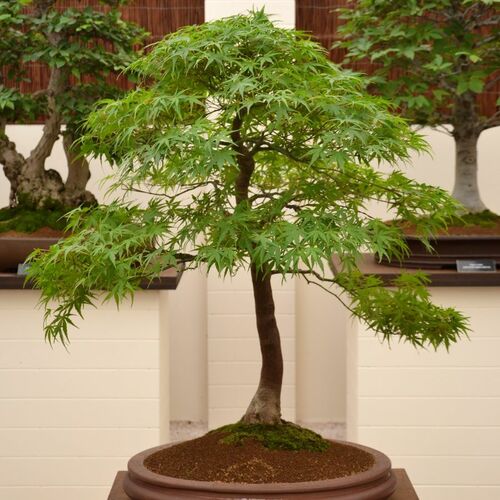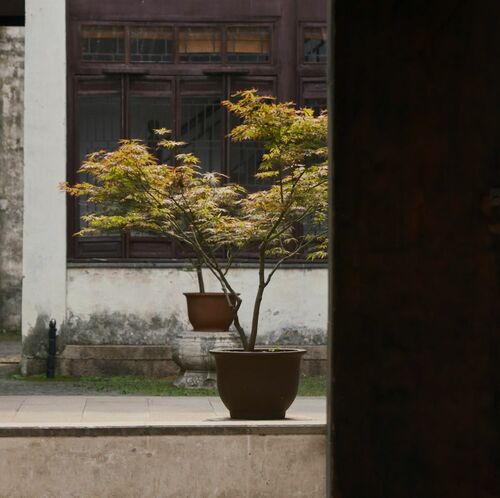Japanese Maple Bonsai Trees
Introduction
Japanese maple bonsai trees are known for their beautiful leaves and elegant forms. This makes them a popular choice among bonsai enthusiasts. These tiny trees have the beauty of full-sized Japanese maples in a fun-sized form. This makes them perfect for small spaces. Japanese maple trees come from Japan, Korea, and China. They are known for their beautiful autumn colors, ranging from fiery red and orange to deep purple. These colors along with their graceful branches make them a favorite for people who grow bonsai trees.
Picking the Right One
When choosing a Japanese maple bonsai, there are a few different things to think about. First is the species of maple you would like. There are many kinds of Japanese maples, each with unique leaf shapes , colors , and growth habits. Second is the size and shape—you should pick a tree with a well-proportioned trunk and branches. The tree should have good potential for shaping and styling. Finally, you should make sure the tree is healthy, with vibrant leaves and no signs of pests or diseases.
How to Care for Your Japanese Maple Bonsai

A Japanese Maple Bonsai on Display – Photo by Tomas Adomaitis
Caring for these trees can be a very rewarding experience. With the right care throughout the year, your tree will stay heathy, beautiful, and fun-sized. Whether you are just starting out or are a bonsai master, understanding how to care for these trees is essential to grow your tree into a thriving Japanese maple bonsai.
Planting and Soil Requirements
These trees prefer soil that doesn’t hold too much water so that it holds moisture, but not enough to waterlog the tree. A good bonsai soil mix is Akadama , pumice, lava rock , and organic compost (in small amounts). The soil should provide good ventilation and allow for proper root development. Make sure to repot your tree every two to three years in the early spring, just before the tree starts to bud.
Watering and Fertilizing
Japanese maples need consistent moisture. The soil should be kept slightly moist but not soggy. The best way to do this is to water the tree thoroughly when the topsoil feels dry to the touch. In hot weather, daily watering may be necessary. A watering can with a fine nozzle is the best tool to use to avoid disturbing the soil.
Fertilizer is an important part of growing your bonsai. A balanced, slow-release fertilizer is the best type to use during the growing season. Organic fertilizers are preferred for this because of their gentle effect on bonsai roots. Your tree should be fertilized every four to six weeks from early spring to late summer. However, after the growing season, you should reduce fertilizing in autumn and stop in the winter.
Light and Temperature Requirements
Japanese maple bonsai trees thrive in bright, indirect sunlight. Too much direct sunlight can scorch the leaves. This is especially true in hot climates. Due to this, it’s best to provide filtered sunlight or partial shade, particularly during the hottest part of the day.
These trees also prefer cooler weather. They can handle light frost but should be protected from freezing temperatures. You can do this by placing them in an unheated greenhouse, a cold frame, or an indoor area with plenty of natural light during the winter.
Pruning and Shaping

Japanese Maple Bonsais Grace a Courtyard – Photo by Seele An on Unsplash
Pruning and shaping these trees is crucial to maintaining their health, beauty, and structure. Although Japanese maples naturally have a graceful form, proper pruning can enhance this and make sure your tree grows healthy and strong.
There are four different pruning techniques you’ll need to prune your tree:
- Structural Pruning: Pick the main trunk and branches that will define your bonsai’s shape. Then, remove any unwanted large branches that do not fit the design. This forms the main shape and structure of the bonsai. This is usually done once and then followed by minor adjustments if needed.
- Maintenance Pruning: Regularly pinch back new growth to encourage denser foliage and a more compact form. Remove any shoots that grow in unwanted directions or that crowd the structure as well. This maintains the shape and refines the structure of the bonsai and is done throughout the growing season.
- Leaf Pruning: Carefully prune larger leaves during the growing season. This is done by cutting the leaf stem and then leaving the base to fall off naturally. Removing some of the leaves from the tree can also balance growth. This makes the leaf size smaller, increasing the number of branches and making it easier for light to reach the lower layers of the trees. This should be done once or twice per growing season, depending on the tree’s vigor and health.
- Root Pruning: Remove about one-third of the root mass, focusing on large, thick roots to encourage fine root growth. This should only be done during repotting, which occurs every two to three years for young trees and every three to five years for older trees.
The best time to prune Japanese maples is during the dormant season, which is late winter to early spring, just before new growth begins. Pruning during dormancy minimizes stress on the tree and reduces the risk of disease. Light pruning and removal of dead or diseased wood can also be done in the summer.
To prune your tree, first start by inspecting the tree and removing any dead, diseased, or damaged branches. This not only improves the tree’s appearance but also prevents the spread of diseases. Then, after making sure your pruning tools have been thoroughly cleaned to prevent diseases, start with structural pruning by removing any large branches that do not fit the desired design. Cut back to a healthy bud or branch to encourage new growth in the right direction. Make sure to also regularly pinch or trim new shoots to maintain the tree’s shape and promote a dense canopy. This encourages branching and a fuller appearance. If necessary, you can also prune leaves to reduce leaf size and improve light penetration. This also helps in balancing the energy distribution within the tree. Finally, when repotting, trim the roots to maintain a compact root system. This supports the tree’s overall health and vigor.
With patience, observation, and proper care, you can effectively prune and shape your Japanese maple bonsai, maintaining its beauty and health for years to come.
Common Pests and Diseases

A Japanese Maple Branch – Photo by Ben Cheung on Pexels
Common pests such as aphids, beetles, and leaf-eating insects can be a problem for Japanese maples. Fungus gnats can also be a problem if soil conditions are too damp. Some ways you can combat these problems are by spraying neem oil or even diluted household dish detergent. It’s important to spray the mixture again seven days later to get rid of newly hatched eggs. This will break the cycle of infestation. Fungal infection can be spotted by looking for a layer on the surface of the trunk or branches as well as looking for discolored leaves. Making sure your tree has proper air circulation can help with these problems. Fungicides can also be helpful. It’s important to remember that healthy trees are stronger trees. The healthier a tree is, the easier it will be to defend against pests and diseases .
Conclusion
Japanese maple bonsai trees are a beautiful and rewarding addition to any bonsai collection. With proper care and attention, these trees can thrive and provide years of enjoyment. By understanding its specific needs, you can help your bonsai grow up to be strong, healthy, and beautiful.
For expert advice on tree care, including bonsai trees, contact Arborist Now today!


